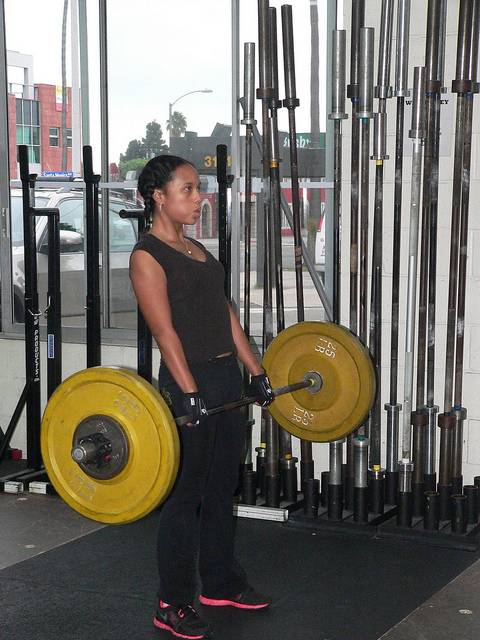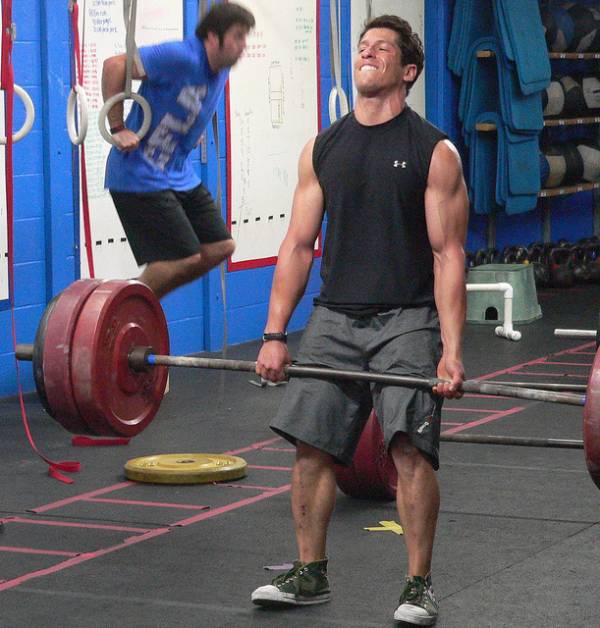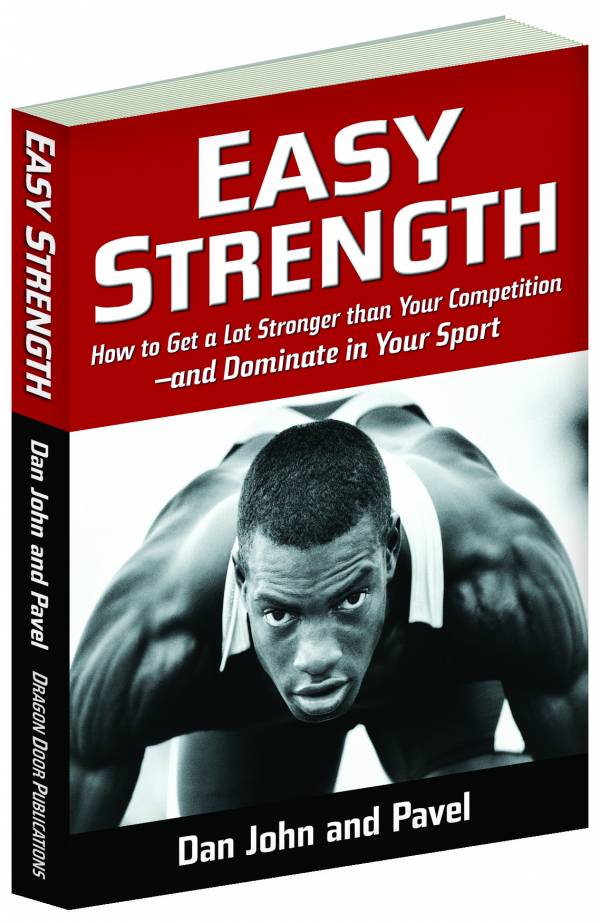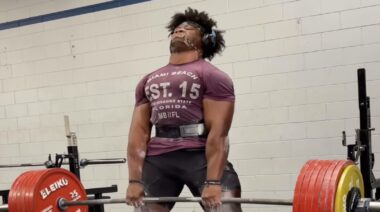I spend the bulk of my time answering questions that are actually pretty simple. “Dan, I want to get bigger. Can you help me?” Yes, eat more and lift heavier. “Dan, I want to get thinner. Can you help me?” Yes, eat less and lift heavier.
You see, I think “lifting heavier” is the answer to most problem. It will short-circuit my political ambitions, “Mr. John, what is your plan for lowering taxes?” “Lift heavier?” So, perhaps it is not a perfect solution. But, from my time in the gym, most trainees are WOEFULLY too weak to meet their body composition and performance goals.
For years, I have argued that you need to have a bodyweight bench press and a double bodyweight deadlift to begin to understand the importance of strength. The issue is obvious to me: everyone and their brother has a bench press plan. I have seen pretty elaborate programs to tweak someone’s training up on the lift and they all work. Ask somebody about the deadlift and they will quote their mom: “Don’t lift with your back.” If you believe that, by the way, show me how you get your shoes off the ground without involving your back.
I think the first key (always!) in thinking about any lift, movement, supplement or idea before adding them to a program is this: what’s the least I can do to utilize this “new” thing. In other words, avoid the problem most people have with any new groovy idea: if a little helps, a lot will be better. When Creatine first snuck out of the quiet confines of some track and field guys and hit the greater world, I was always astounded to find out how many guys got massive cramps and diarrhea. I then found out that guys would triple (and more) the recommended serving. The same is true for fat loss supplements and some people have had to check themselves into the hospital to slow down a raging heartbeat.
Please don’t ask me to repeat what Doctor Brunetti told me about a patient who got some Viagra and took four times the right dose. Don’t let me even think about it again, please.
So, I think that the deadlift is a crucial human movement. I believe it is part of a typical strength athlete’s program. In fact, I think everyone can benefit from some pulling from the floor.
 Now, before you ask about the Viagra overdose, think about the deadlift overdose: it is a great lift, it does wonders, now, stop it. Don’t go there. And where is “there?” “There” is this idea, this notion, that if a little is good a massive amount is better.
Now, before you ask about the Viagra overdose, think about the deadlift overdose: it is a great lift, it does wonders, now, stop it. Don’t go there. And where is “there?” “There” is this idea, this notion, that if a little is good a massive amount is better.
Back to the premise: the deadlift is a basic human movement and deserves to be in everyone’s training regimen.
But now I am often asked: why do your athletes deadlift so much? So much what? Are we talking volume, intensity, or load? We do a lot of deadlifts, but we never go heavy, save every so often!
You may still ask, “Why do your athletes deadlift so much?” Ah, you mean the numbers on the wall. You are referring to those staggering max numbers that amaze some people and scare some parents. You are discussing the deadlift max.
I need to be clear about deadlift maxs here: I don’t think one necessarily EVER has to attempt. I never have. Not even one time! In Junior College, the Pacifica Barbell Club record in my weight class for the deadlift was 550. So, one day, Dick Notmeyer and I decided to break it. I went to 555 and made the lift and I owned the record.
A year or so later, Bob Arello challenged me to deadlift 600. In the gym, we didn’t have many small plates (they break easy under lots of use) so I pulled 605. A few years later, in the wee small hours of the morning (3 a.m.), I was the last guy deadlifting at a contest and just told the guy to put on five more pounds (2.5 kilos actually) to the amount the guy just missed and I pulled a 628 deadlift.
My students follow my exact plan!
I can see some hands going up, so let me save you some energy, “What plan?”
You can drive your deadlift up to amazing numbers by NEVER deadlifting heavy. In fact, sometimes I think it is actually counterproductive to pull heavy deadlifts. But, you need to hear this:
 You need to lift hard in a wide range of movements to have a massive deadlift without deadlifting! My athletes front squat every workout. We do lots of hip mobility work. We snatch and clean and jerk all the time. We swing, snatch, and move kettlebells every session. We deadlift, clean curl (power curl) and do pull-ups as part of a normal day. Most of my athletes train at 50% of their max deadlift BUT mix them with other lifts and keep the reps fairly high on the movement.
You need to lift hard in a wide range of movements to have a massive deadlift without deadlifting! My athletes front squat every workout. We do lots of hip mobility work. We snatch and clean and jerk all the time. We swing, snatch, and move kettlebells every session. We deadlift, clean curl (power curl) and do pull-ups as part of a normal day. Most of my athletes train at 50% of their max deadlift BUT mix them with other lifts and keep the reps fairly high on the movement.
And then, just a few times a year, and for many just once a year, we go after a number. Personally, I see no value in adding ten pounds to your max deadlift. If you pull 400, I would love to see you attack your quick lifts, grind out some squats, do some hurdle work, jump on a few boxes, pull some sleds, carry some farmer bars, and swing some kettlebells for a long time before you max again. And, when you do, jump right up to 450 or 500 instead of tossing on a few puny plates. Attack your max!
Have a friendly competition or enter a meet, but don’t just wander in by yourself, load the bar and go, “Ooooh, that FEELS heavy.” Pretend your kid is under the plates and wedge it off of them. If you have no kids, pretend it is me!
So, here is a typical training circuit. It is called “On the Minute” and it works well with large groups. To me, a large group is thirty to eighty athletes at once. We set up our stations at “on the minute,” and the athletes perform the reps, let say three in this example. Athlete one goes first and his partner spots and then they switch. You can get up to four a station, but it gets crowded. Then, we add some weight. It takes a time or two to nail down the weight increases to manage the number of sets. I have found in large groups that eight sets are ideal. Many will argue with me on that large number, but the first sets are light warm ups and the speed of the rest period keeps the load down.
“One the Minute” – Eight Sets of Three
- Front Squats
- Bench Press
- Hurdle Walkovers (Flight of ten hurdles, just marches “High Knee style” over them each minute; it is a hip mobility drill and a bit of a rest)
- Backward Sled Pulls (In this case, a 20m sled pull, hand the reins over to your partner and just do one a minute)
- Deadlifts
In big groups, you will have athletes start at every lift and they will move to the next exercise after the eight sets (logically, this will take eight minutes, but it really more like ten with transitions) are finished.
For eight sets of three on the minute for deadlifts, a strong athlete will still just start with 135 and probably not even sneak up on much past 255 for the workout. With all the movements, this is not the time to crank up a big pull. But, the lifter will be greasing the movement with 24 repetitions all done under the extra load of time, partner issues and the aggregate work down through the workout. (This is true for all the movements) Moreover, the lifter is also stressing the body in so many ways that super-compensation is just around the corner with some rest and food.
When it is time to max, be sure you have nothing crucial for about three weeks. Now, in other words, don’t max deadlift the day before the Olympic Trials. You are simply trying to get a measure of your absolute strength. Honestly, a couple of standing long jumps a few times a year would be as good, but I have the same issues: I like to move heavy iron.
 For the record, I have no interest in “what you could have made.” Please no failures on max deadlifts – make the lifts! For whatever reasons, max deadlifts seem to take a ton out of your central nervous system and it doesn’t come back easily. Max deadlift misses seem to take even more of the body. So, make the damn lift!
For the record, I have no interest in “what you could have made.” Please no failures on max deadlifts – make the lifts! For whatever reasons, max deadlifts seem to take a ton out of your central nervous system and it doesn’t come back easily. Max deadlift misses seem to take even more of the body. So, make the damn lift!
I don’t suggest more than two max attempts and most people are only good for six deadlifts in a heavy workout. So, I consider that warm up with 135 for a single part of the six. If you don’t know how to deadlift perfectly, or at least properly, don’t use a max as a teaching unit. Please, know what you are doing when you grip the bar and leave it all on the table for these few attempts.
Does it work? Oh, absolutely. I love to tease men who are using an exaggerated vocabulary about some minute fitness detail and tell them that they are “almost” as strong as my Homecoming Queen with a 355 deadlift.
So, save those max efforts for max efforts!
Can a powerlifter use this approach? Well, there are a few issues: first, not so much the grip, but I worry about the skin of the hands. Maximal deadlifts tend to rip the hands in a way that is honestly hard to mimic. The hand toughness needed to yank a huge weight off the ground is hard to train outside of yanking huge plates off the ground. Second, there is a need for rooting, wedging, and synchronizing everything that is hard to practice outside of deadlifts.
But, for pure absolute strength gains, I think it is still possible to harvest benefits from non-deadlifting activities. I think a good deadlift coach probably has a number of arrows in his deadlifting quiver and can pick and choose elements to focus on, and to ignore, over the course of a career. There are some who will flourish on more pure deadlift work and others who can just step up to the bar at a meet and pull the bar off the floor. So, with great clarity I would argue that a powerlifter’s deadlift training would come under the banner: it depends!
 You can learn more about Dan John’s strength training philosophy in his new book, co-written with Pavel Tsatsouline – Easy Strength.
You can learn more about Dan John’s strength training philosophy in his new book, co-written with Pavel Tsatsouline – Easy Strength.
To learn more about Dan read our feature interview:
Featured Coach: Dan John, Part 1 – The State of the Fitness Union
To follow Dan’s workouts here on Breaking Muscle follow this link:






